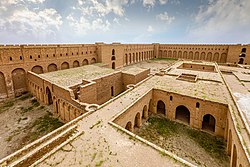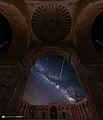Al-Ukhaidir Fortress
| Al-Ukhaidir Fortress | |
|---|---|
حصن الأخيضر | |
| Karbala Governorate, Iraq | |
 Al-Ukhaidir Fortress near Karbala in Iraq | |
| Coordinates | 32°26′26″N 43°36′08″E / 32.440556°N 43.602222°E |
| Type | Castle |

The Fortress of Al-Ukhaidir (Arabic: حصن الأخيضر) or Abbasid palace of Ukhaider is located roughly 50 km south of Karbala, Iraq. It is a large, rectangular fortress erected in 775 AD with a unique defensive style. Constructed by the Abbasid caliph As-Saffah's nephew Isa ibn Musa,[1][2] Ukhaidir represents Abbasid architectural innovation in the structures of its courtyards, residences and mosque. Excavations at Ukhaidir were conducted in the early 20th century by Gertrude Bell, who wrote the first major report on the remains.[3] Ukhaidir was an important stop on regional trade routes, similar to Atshan and Mujdah.[4] The complex comprises a primary hall, a large Iwan, a reception hall and servants quarters.[4] The fortress exemplifies Abbasid architecture in Iraq by demonstrating the "despotic and the pleasure-loving character of the dynasty" in its grand size but cramped living quarters.[5]
The current name could be related to Isma'il ibn Yusuf al-Ukhaidhir from Banu Ukhaidhir who launched a rebellion against the Abbasid, then later he became the governor of Kufa with the support of Qarmatians.[6]
World Heritage Status
[edit]This site was added to the UNESCO World Heritage Tentative List on July 7, 2000, in the Cultural category.[4]
Gallery
[edit]Notes
[edit]- ^ Creswell, Keppel Archibald Cameron (1958). A short account of early Muslim Architecture. Penguin Books. pp. 201–203.
- ^ "Stepping back 1,300 years into Iraq's Ukhaidir palace - Al-Monitor: The Pulse of the Middle East". 3 December 2015.
- ^ Bell, Gertrude (1914). Palace and Mosque at Ukhaidir: A Study in Early Mohammadan Architecture. Oxford: Clarendon Press.
- ^ a b c The Fortress of Al-Ukhaidar - UNESCO World Heritage Centre
- ^ Hillenbrand (1999).
- ^ Houtsma, M. Th. (1993). E.J. Brill's first encyclopaedia of Islam, 1913-1936. Leiden ; New York : E.J. Brill. p. 994. ISBN 9004097961.
References
[edit]- Ukhaidir (Iraq) - About.com Archived 2009-09-27 at the Wayback Machine Accessed 2009-09-25.
- Hillenbrand, R (1999), Islamic Art and Architecture, Thames and Hudson, 1999. ISBN 0-500-20305-9
Text is available under the CC BY-SA 4.0 license; additional terms may apply.
Images, videos and audio are available under their respective licenses.











